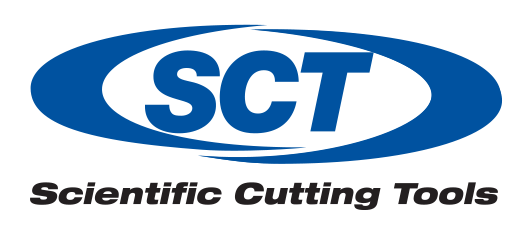Indexable Boring Technical Support
If you’re using CBN or PCD inserts, click here instead.
Jump to:
Speed and Feed Chart
| Material | HB/Rc | Uncoated SFM | AlTiN+ SFM | Maximum DOC for ACD & ATD | Maximum DOC for ATP & ACP | Feed IPR |
|---|---|---|---|---|---|---|
| Cast Iron | 160 HB | 75-200 | 200-550 | 0.020 | 0.060 | .0005-.010 |
| Carbon Steel | 18 Rc | 75-200 | 200-450 | 0.018 | 0.060 | .0005-0.010 |
| Alloy Steel | 20 Rc | 75-200 | 200-425 | 0.015 | 0.060 | .0005-0.010 |
| Tool Steel | 25 Rc | 75-175 | 175-300 | 0.010 | 0.030 | .0005-0.010 |
| 300 Stainless Steel | 150 HB | 75-175 | 175-350 | 0.015 | 0.028 | .0005-0.010 |
| 400 Stainless Steel | 195 HB | 75-210 | 130-420 | 0.012 | 0.028 | .0005-0.010 |
| High Temperature Alloy (Ni & Co Base) | 20 Rc | 50-130 | 130-300 | 0.008 | 0.020 | .0005-0.010 |
| Titanium | 25 Rc | 50-120 | 120-275 | 0.009 | 0.022 | .0005-0.010 |
| Heat Treated Alloys (38-45 Rc) | 40 Rc | 50-100 | 100-200 | 0.005 | 0.010 | .0005-0.010 |
| Aluminum | 100 HB | 75-250 | 250-750 | 0.025 | 0.095 | .0005-0.010 |
| Brass, Zinc | 80 HB | 75-300 | 250-650 | 0.023 | 0.090 | .0005-0.010 |
SFM = Surface Feet per Minute
These are starting parameters only. Length to Diameter ratios, setup, and machine rigidity may affect performance. This chart reflects the maximum Depth of Cut (DOC) acceptable at the minimum Inches per Revolution (IPR).
Which Indexable Boring Bar Should I Choose?
Verify Hole Diameter
Start by checking the diameter of the hole to be machined using the part or print. Choose a boring bar with a minimum bore diameter smaller than the required machining diameter.Check Machine Compatibility
Determine the correct shank size for your machine. If a larger shank is needed, consider using a step bar.Select the Appropriate Lead Angle
Use a 0° lead for boring to a shoulder.
Use a 5° lead for boring and facing a shoulder.
Choose the Right Insert
Select between a flat top or chip control insert based on the application and material being machined.Determine the Corner Radius
Choose from .003”, .007”, or .015” radius options based on the desired finish and part specifications.
Which Insert Grade Should I Choose?
| Type | Description |
|---|---|
| Uncoated | Submicron premium carbide grade for machining steel and non-ferrous materials. |
| AlTiN+ | Premium coated grade for steel, cast irons, and high-temperature alloys at highest SFM |
| CBN | Ideal for hardened steeeel (45+ Rc) and cast iron |
| PCD | Ideal for non-ferrous materials |
Troubleshooting
| Problem | Cause | Solution |
|---|---|---|
| Rapid Flank Wear | Cutting Conditions | Reduce the cutting speed. |
| Insert | Select a coated grade. | |
| Heat | Use the SCT coolant holder. If coolant is not available, use shop air and a coated tool. Use a coolant through boring bar. | |
| Built-Up Edge | Insert | Select a coated grade. |
| Cutting Force | Use chip control insert to free up cut. | |
| Heat | Use coolant through boring bar or holder. If coolant is not available, use shop air and a coated tool. Use a coolant through boring bar. | |
| Insert Breakage | Cutting Conditions | Reduce Depth of Cut. Reduce feed rate. |
| Insert | Select a larger corner radius. | |
| Part | Check the drilled hole to make sure the full diameter of the drill is deeper than the programmed bore depth. | |
| Surface too Rough | Cutting Conditions | Reduce feed rate. The rate is too great for the nose radius. |
| Insert | Select a larger corner radius. The feed rate (IPR) should not be greater than 1/2 the nose radius. | |
| Chatter | Setup | Set insert above center. Change the speed of the machine. The overhang ratio should be less than eight times the bar diameter for carbide. Clamping length should be at least three times the boring bar diameter. |
| Boring Bar | Select the largest diameter bar that will bore the required diameter. | |
| Taper Bigger in Back | Cutting Forces | Forces may deflect bar below center causing the hole to become larger. |
| Built-Up Edge | A built-up edge will cause the hole to become large until the built-up edge breaks off, then the hole will be smaller. | |
| Program | If the taper is consistent (not from chip packing), then the program can be altered to bore a taper in the opposite direction, resulting in a straight hole. | |
| Taper Smaller in Back | Chip Packing | If the boring bar is too large to allow chips to evacuate, then the chips may pack on the insert and cause the bar to deflect away from the bore. |
| Program | If the taper is consistent (not from chip packing), then the program can be altered to bore a taper in the opposite direction, resulting in a straight hole. |

